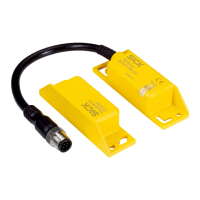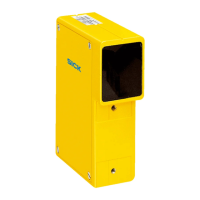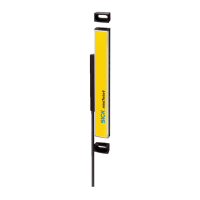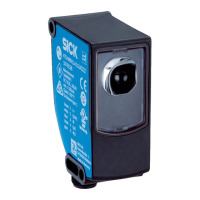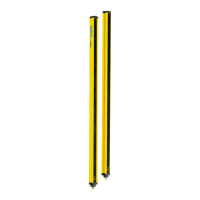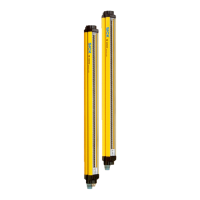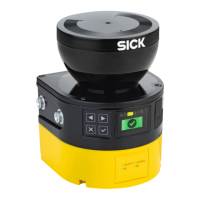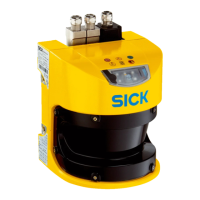Thorough check of the area to be protected
T
he area to be protected and the detection capability are checked during this thorough
check.
The thorough check covers the following points:
•
Changes in the detection capability (thorough check of all configured fields)
•
Modifications, tampering and damage to the protective device or the machine,
which lead to changes in the area to be protected or the position of the protective
field
Recommended approach for hazardous area protection:
b
Position the supplied test object at a number of points at the edges of the area to
be protected. The safety laser scanner must detect the test object at each position
and indicate the detection. How it is indicated depends on the configuration. The
number and position of sites where the thorough check is carried out must be cho‐
sen so that undetected access to the hazardous area is impossible.
b
If a number of protective fields are used (in different monitoring cases for exam‐
ple), check the edges of all protective fields.
Recommended approach for access protection and hazardous point protection:
b
Move the supplied test object along the edges of the area to be protected. The
safety laser scanner must detect the test object at each position and indicate the
detection. How it is indicated depends on the configuration. The protective field
must be dimensioned such that reaching around or going around it is impossible.
b
If a number of protective fields are used (in different monitoring cases for exam‐
ple), check the edges of all protective fields.
b
If the reference contour monitoring feature is used, check the areas with the refer‐
ence contour:
°
Move the test object along the inner edge of the tolerance band of the refer‐
ence contour. The safety laser scanner must detect the test object at each
position and indicate the detection.
°
If several reference contours are used, test all reference contours.
Recommended approach for mobile hazardous area protection:
b
Place the supplied test object in the path of the vehicle and check whether the
vehicle comes to a stop in time.
b
If a number of protective fields are used (in different monitoring cases for exam‐
ple), check whether the vehicle comes to a stop in time in all of the protective
fields.
b
If necessary, change the position of the test object so that a thorough check is car‐
ried out for each monitoring case to determine whether the protective field is
active over the whole of the required width.
b
Check the height of the scan plane. The scan plane must be at a height of at least
200 mm so that people lying down can be reliably detected. For this purpose, posi‐
tion the supplied test object at a number of points at the edges of the area largest
protective field. The safety laser scanner must detect the test object at each posi‐
tion and indicate the detection. How it is indicated depends on the configuration.
If the thorough check reveals a fault, the machine should be shut down immediately. In
this case, the mounting and electrical installation of the safety laser scanner must be
checked by appropriately qualified safety personnel.
Test of the contour detection field
If y
ou use contour detection fields, you must test whether each contour detection field
fulfills the intended function.
Notes on planning the test
•
Which contour should be detected at which position? What is the desired result?
•
What is the desired result if the contour is not at the position?
4 P
ROJECT PLANNING
46
O P E R A T I N G I N S T R U C T I O N S | nanoScan3 I/O 8024596/15VP/2019-11-15 | SICK
Subject to change without notice

